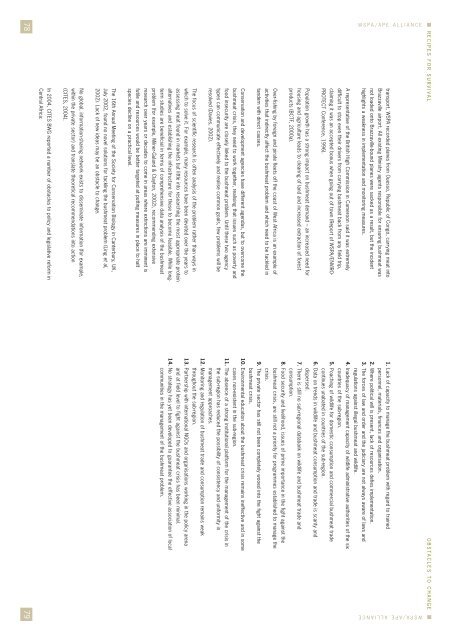Recipes for Survival_English_tcm46-28192
Recipes for Survival_English_tcm46-28192
Recipes for Survival_English_tcm46-28192
- No tags were found...
You also want an ePaper? Increase the reach of your titles
YUMPU automatically turns print PDFs into web optimized ePapers that Google loves.
WSPA/APE ALLIANCERECIPES FOR SURVIVALtransport, WSPA recorded planes from Ouesso, Republic of Congo, carrying meat intoBrazzaville airport. All existing Ministry agents responsible <strong>for</strong> ensuring bushmeat wasnot loaded onto Brazzaville-bound planes were sacked as a result, but the incidenthighlights a weakness in implementation and monitoring measures.A representative of the British High Commission in Cameroon said it was extremelydifficult to stop even their drivers from carrying bushmeat back from any field trip,claiming it was an accepted bonus when going out of town (Report of WSPA/ENVIRO-PROTECT Conference, 1996).Population growth has a strong impact on bushmeat demand – an increased need <strong>for</strong>housing and agriculture leads to clearing of land and increased extraction of <strong>for</strong>estproducts (BCTF, 2000a).Over-fishing by <strong>for</strong>eign and pirate fleets off the coast of West Africa is an example ofactivities that indirectly affect the bushmeat problem and which need to be tackled intandem with direct causes.Conservation and development agencies have different agendas, but to overcome thebushmeat crisis, they need to work together, realising that issues such as poverty andfood insecurity are closely linked to the bushmeat problem. Until these two agencytypes can communicate effectively and realise common goals, few problems will beresolved (Davies, 2002).The focus of scientific research is often analysis of the problem rather than ways inwhich to solve it. For example, many resources have been devoted over the years toassessing meat found in markets but little into researching the most appropriate proteinalternatives and establishing the infrastructure <strong>for</strong> these to become feasible. While longtermstudies are beneficial in terms of comprehensive data analysis of the bushmeatproblem (<strong>for</strong> example, Milner-Guland & Clayton, 2002), recommending extensiveresearch over years or decades to come in areas where extinctions are imminent isfutile and resources would be better targeted at putting measures in place to haltspecies decline on a practical level.The 16th Annual Meeting of the Society <strong>for</strong> Conservation Biology in Canterbury, UK,July 2002, found no novel solutions <strong>for</strong> tackling the bushmeat problem (Ling et al,2002). Lack of new ideas may be an obstacle to change.No global, in<strong>for</strong>mation-sharing network exists to disseminate in<strong>for</strong>mation (<strong>for</strong> example,within the private sector) and translate theoretical recommendations into action(CITES, 2004).In 2004, CITES BWG reported a number of obstacles to policy and legislative re<strong>for</strong>m inCentral Africa:OBSTACLES TO CHANGE1. Lack of capacity to manage the bushmeat problem with regard to trainedpersonnel, materials, finances and organisation.2. Where political will is present, lack of resources defies implementation.3. The <strong>for</strong>ces of law and order and the judiciary are not always aware of laws andregulations against illegal bushmeat and wildlife.4. Inadequacy of management capacity of wildlife administrative authorities of the sixcountries of the sub-region.5. Poaching of wildlife <strong>for</strong> domestic consumption and commercial bushmeat tradecontinues unabated in countries of the sub-region.6. Data on trends in wildlife and bushmeat consumption and trade is scanty anddispersed.7. There is still no sub-regional databank on wildlife and bushmeat trade andconsumption.8. Food security and livelihood, issues of prime importance in the fight against thebushmeat crisis, are still not a priority <strong>for</strong> programmes established to manage thecrisis.9. The private sector has still not been completely wooed into the fight against thebushmeat crisis.10. Environmental education about the bushmeat crisis remains ineffective and in somecases non-existent in the sub-region.11. The absence of a strong institutional plat<strong>for</strong>m <strong>for</strong> the management of the crisis inthe sub-region has reduced the possibility of consistency and uni<strong>for</strong>mity inmanagement approaches.12. Monitoring and regulation of bushmeat trade and consumption remains weakthroughout the sub-region.13. Partnership with international NGOs and organisations working in the policy arenaand at field level to fight against the bushmeat crisis has been minimal.14. No strategy has yet been developed to guarantee the effective association of localcommunities in the management of the bushmeat problem.79WSPA/APE ALLIANCE78


